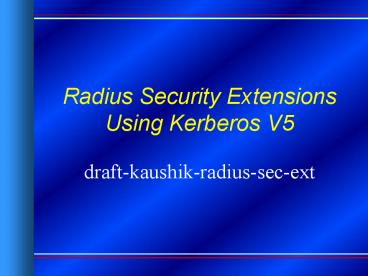Radius Security Extensions Using Kerberos V5 - PowerPoint PPT Presentation
Title:
Radius Security Extensions Using Kerberos V5
Description:
Kerberos used to provide authentication, encryption and data integrity. ... operation and non negligible ticket lifetime reduces the computational intensity. ... – PowerPoint PPT presentation
Number of Views:57
Avg rating:3.0/5.0
Title: Radius Security Extensions Using Kerberos V5
1
Radius Security Extensions Using Kerberos V5
- draft-kaushik-radius-sec-ext
2
About this draft
- Attempt to address problems with AAA security,
especially the problems in inter domain
operations. - Kerberos used to provide authentication,
encryption and data integrity. - Radius was a chosen since it is the base protocol
for AAA and it was possible to implement the
extensions and look at performance issues.
3
Key points of the draft
- Kerberos security contexts setup across Radius
peers using Radius protocol to carry Kerberos
messages for context establishment. - Supports Hop by Hop and End to End Proxy
operation. - Fully backward compatible and can work through
existing Radius servers and proxies. - A prerequisite is that the Ticket Granting Ticket
should have been already obtained. PKINIT can be
employed to obtain TGT. - Makes use of DNS for discovery of remote realm
Radius server and remote realm Key Distribution
Center (KDC).
4
Kerberos Operation (Mutual Authentication)
5
Kerberos Operation
- 1 - KRB_AS_REQ - Get the Ticket Granting Ticket
- 2 - KRB_AS_REP - AS replies with the TGT
- 3 - KRB_TGS_REQ - Obtain a ticket for the service
principal. - 4 - KRB_TGS_REP - Ticket Granting Server responds
with ticket for the service principal and the
session key. The ticket is encrypted with the
servers key and the session key would be
encrypted with the key sent in the Ticket
Granting ticket. - 5 - KRB_AP_REQ - The Client would send the
Application request which contains the Ticket
received from the TGS and the authenticator to
the verifier. The authenticator is generated by
the Client and encrypted with the session key. - 6 - KRB_AP_REP - The verifier would first decrypt
the ticket and extract the session key. The key
used to decrypt the ticket would be stored in a
key tab file. The verifier would then decrypt the
authenticator using the session key and
authenticate the client. On successful
authentication the Verifier would reply back with
an authenticator for mutual authentication. - The authenticator sent back is verified by the
Client. On successful mutual authentication a
Kerberos security context is created.
6
Summary of Changes
- Three new Radius attributes.
- Kerberos Mode - mode of operation.
- Kerberos Data - Carries the Kerberos messages
(KRB_AP_REQ and KRB_AP_RES) - Kerberos Crypt - Carries the block of encrypted
AVPs or the Integrity Checksum of the AVP block.
7
Normal Mode Kerberized Radius
8
End to End Proxy Mode
9
Hop by Hop Proxy Mode
10
Advantages of Kerberos
- Mutual authentication of both the client and the
server - Simple inter domain trust management
- Symmetric key operation and non negligible ticket
lifetime reduces the computational intensity. - Kerberos can be easily implemented on a embedded
devices. - Small code size requirements.
- Kerberos is entirely based on open standards with
a well tested and widely understood reference
implementation. - Kerberos is a mature standard which has been
scrutinized cryptologists and security experts
11
What about Kerberized Diameter
- Radius is a stateless protocol and every request
and response would need a new security context - Kerberos Security contexts could be created and
saved for the length of a Diameter session. - New composite mode which combines End to End and
Hop by Hop modes. - Kerberos support for Public Key Security.
12
End to End and Hop by Hop
13
End to End and Hop by Hop
- End to End and Hop by Hop themselves dont solve
all inter domain problems. - In most AAA scenarios there is need for certain
attributes to be encrypted attributes end to end
and certain other attributes to be visible on a
hop by hop. - Composite mode would enable certain attributes to
be encrypted on an end to end basis and certain
other attributes to be decrypted/verified and
re-encrypted/resigned on a hop by hop basis.































